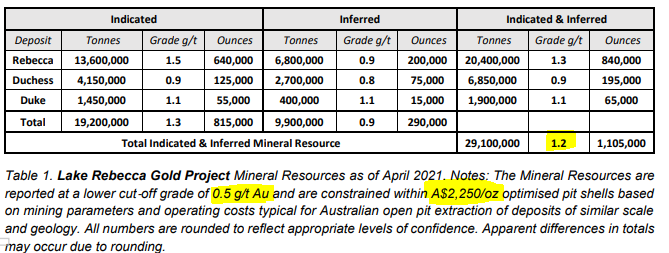Cut-off grades explained
Published 22-MAR-2022 04:00 A.M.
|
4 minute read
A cut-off grade is the grade of mineralisation that a deposit can be economically mined and dictates which drilling intercepts can and can’t be used in a JORC resource.
The cut-off grade is determined by the cost to mine a deposit, and the price that a company can sell the underlying commodity.
The higher the cost to mine, the higher the cut-off grade, whereas the higher the price of the commodity the lower the cut-off grade.
As an investor reading a JORC resource estimate, it is important to pay attention to the ‘cut-off grade’, as it dictates which drilling intercepts can and can’t be used in the JORC resource estimate and ultimately the size of the economically mineable JORC resource.
You can read more about how to read a JORC resource here.
Shallow vs deep deposit
The depth of a mineral deposit directly affects the cost to mine that deposit and therefore cut-off grade.
Shallow and near surface deposits have a lower cut-off grade because they are mined at lower costs - it is cheaper to mine things that are closer to the surface with an open pit mine.
Deep, underground deposits require a higher cut-off, as the cost to mine is higher - it is generally more expensive to build a deep underground mine and extract the mineral.
To explain this concept, take a look at Bellevue Gold’s underground JORC resource which is predominantly between 200-1000m below the ground.
Here the company has used a cut-off grade of 3.5g/t and the resource is grading between 9.9g/t.

Now let's look at Ramelius Resources’ gold project which is an open pit shallow resource.
Here the company used a gold price of AU$2,250/Oz to get a cut-off grade of 0.5g/t for its deposit where mineralisation starts near surface and extends to a max depth of ~325m.

Discover the 5 Battery Materials Stocks we’ve Invested in for 2023
Why is cut-off grade important for a JORC resource?
For a new discovery, the cut-off grade determines which drilling intercepts collected during the drilling campaign can be incorporated into a JORC resource.
For example, if the cut off grade is set at 0.5g/t then any drilling results with mineralisation less than 0.5g/t can’t be included in the JORC resource model.
Any intercepts above will be put into the model and form part of the JORC resource.
Below is an example of how a cut off grade changes the size of a JORC resource from one of our portfolio companies Los Cerros (ASX:LCL).

As the cut-off decreases the size of the JORC resource increases significantly, the difference between the 0.5g/t cut-off and the 0.25g/t cut-off is ~1m ounces of gold.
How do commodity prices affect cut-off grade?
The higher the underlying commodity price the lower the cut-off grade required.
This is simply a function of revenue generated from selling the mineral vs costs to extract the mineral.
Using a hypothetical gold mine as an example:
Scenario A) If the cost to extract 1 gram of gold from 1 tonne of ore is ~$50 per gram, and the gold price is trading at $25 per gram then a cut-off of at least 2g/t is required for a resource estimate, anything below this would be considered uneconomic.
Scenario B) If the cost to extract 1 gram of gold from 1 tonne of ore is ~$50 per gram and the gold price is trading at $100 per gram then a cut off at or above 0.5g/t may be considered economic.

As you can see, the higher the gold price, the lower the cut-off grade required for economic extraction.
This is important because when the price of a commodity is depressed a JORC resource may be considered small, but when the commodity increases in price, the JORC resource may become significantly larger without any additional drilling, purely based on a change in the cut-off grade used when building a resource model.
As a mining producer, there are other costs to consider beyond the “cost to extract” like location, existing infrastructure and ease of access, which all play a role in calculating a cut-off grade.
Mining companies will generally try to get to a more conservative estimate of an acceptable cut-off by looking at already operational mines in the same area and then overlaying the commodity price.
Key takeaways for cut off grades:
- A cut-off grade is the grade at which a mineral deposit can be economically mined or processed.
- Cut-off grades can change based on a number of factors, including the type of deposit (shallow or deep), commodity prices, ease of access, location and many more factors that impact costs of mining.
- Cut off grades determine which drilling intercepts are allowed to be incorporated into a JORC resource model.
General Information Only
S3 Consortium Pty Ltd (S3, ‘we’, ‘us’, ‘our’) (CAR No. 433913) is a corporate authorised representative of LeMessurier Securities Pty Ltd (AFSL No. 296877). The information contained in this article is general information and is for informational purposes only. Any advice is general advice only. Any advice contained in this article does not constitute personal advice and S3 has not taken into consideration your personal objectives, financial situation or needs. Please seek your own independent professional advice before making any financial investment decision. Those persons acting upon information contained in this article do so entirely at their own risk.
Conflicts of Interest Notice
S3 and its associated entities may hold investments in companies featured in its articles, including through being paid in the securities of the companies we provide commentary on. We disclose the securities held in relation to a particular company that we provide commentary on. Refer to our Disclosure Policy for information on our self-imposed trading blackouts, hold conditions and de-risking (sell conditions) which seek to mitigate against any potential conflicts of interest.
Publication Notice and Disclaimer
The information contained in this article is current as at the publication date. At the time of publishing, the information contained in this article is based on sources which are available in the public domain that we consider to be reliable, and our own analysis of those sources. The views of the author may not reflect the views of the AFSL holder. Any decision by you to purchase securities in the companies featured in this article should be done so after you have sought your own independent professional advice regarding this information and made your own inquiries as to the validity of any information in this article.
Any forward-looking statements contained in this article are not guarantees or predictions of future performance, and involve known and unknown risks, uncertainties and other factors, many of which are beyond our control, and which may cause actual results or performance of companies featured to differ materially from those expressed in the statements contained in this article. S3 cannot and does not give any assurance that the results or performance expressed or implied by any forward-looking statements contained in this article will actually occur and readers are cautioned not to put undue reliance on forward-looking statements.
This article may include references to our past investing performance. Past performance is not a reliable indicator of our future investing performance.



